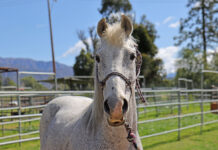You’ve probably come across a horse-related article or two in your local paper. Usually they’re nice human interest pieces about a successful local equestrian or some sort of riding program in the area. Every once in a while, though, you’ll read one of these articles that was so clearly written by a non-equestrian that you just have to laugh.
You can find Saddlebreds at dressage shows, but you’d be hard-pressed to find dressage classes at Saddlebred shows. Outside of a couple of western pleasure classes, every single ridden class at the show in question is a saddle seat class. Now, I’m not going to kid myself into thinking that the average non-equestrian cares what the discipline is called, but mistaking saddle seat for dressage is sort of like referring to break dancing as ballet. Sure, they’re both dance, and they both take a great deal of both training and natural talent to perfect, but that’s pretty much where the similarities end.
Okay, so at some point this writer was misinformed about the discipline at this show. Simple mistake. Sometimes the telltale signs that your equestrian reporter is not an equestrian are a bit weirder. Here are some examples I’ve run across.
-One article on a local boy headed to a regional competition mentions that he will be “…racing his horse in western pleasure and western trail class…” Even the headline refers to the boy racing his horse at this event, which is quite clearly a show, not a race. It’s probably not advisable to race in your western pleasure class, though it might be kinda fun.
-An article on a versatile high school rider who competes in both hunt seat and saddle seat describes saddle seat as a “type of English ladies style from the 18th century.” Well, like most equestrian sports, saddle seat started out quite male-dominated (would women have chosen those three-piece suits and ties as show attire? I think not.) Plus, it didn’t really start to become the discipline we know today until after the Civil War. I’m going to give the writer the benefit of the doubt and assume that he or she did not just make this stuff up, but it does make you wonder where the info came from.
-In covering a county fair, one newspaper reporter described English riding competition as featuring “distinctive square saddles…” Square saddles? I don’t know what shape I would use to describe an English saddle, but square doesn’t make my top ten list.
To be fair, if I had to cover pretty much any non-equestrian sport, I’d be completely lost and would probably make gaffes far more amusing than the ones above. So, in spite of all this, props to the local reporters who get stuck with the equestrian beat. The horse world needs all the positive coverage it can get, and not just because it provides entertainment for me.
Back to The Near Side





That’s funny! Even some of my I-don’t-care-about-horses friends know the difference between a saddle seat class and dressage.
I have watched several Saddlebred shows. When Saddlebreds become aggravated, alarmed, taken out of their stalls, or over-gingered, they naturally side pass across the ring. I definitely think that they would make excellent parade/dressage horses. This would be a great reform to the Saddlebred industry. That old tradition would become modernized.
I thought this was very funny!